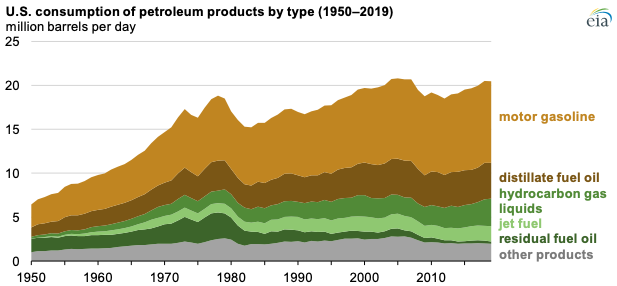Petroleum was the largest primary source of energy consumed in the United States in 2019, accounting for 37% of total energy consumed. In 2019, motor gasoline accounted for about 45% of petroleum products consumed in the United States.
Petroleum is produced from the ground as crude oil or is separated from natural gas as natural gas liquids, and then it is processed at refineries to make many different consumable petroleum products, such as motor gasoline, diesel, propane, and jet fuel. The United States consumes more petroleum than it produces; the rest is supplied by imports from other countries and from domestic stock inventories saved for later use.
The United States was the world’s largest petroleum producer last year. In 2019, U.S. total field production of crude oil grew to a record of more than 12 million b/d. Production of natural gas liquids reached a record of almost 5 million b/d. U.S. petroleum production has increased significantly during the past 10 years, as a result of production techniques in tight rock formations developed using horizontal drilling and hydraulic fracturing to extract hydrocarbons.
Crude oil imports accounted for most U.S. petroleum trade in 2019; however, crude oil imports fell to less than 7 million b/d, the lowest level since 1993. The United States also imported about 2 million b/d of all petroleum products.
In 2019, U.S. exports of crude oil reached a record of nearly 3 million b/d, up about 45% from 2018. U.S. crude oil exports have increased significantly since the beginning of 2016, after the U.S. Congress lifted restrictions on exporting crude oil. In addition, the United States exported about 5.5 million b/d of all petroleum products in 2019, a 1% decrease from the previous year. Despite near record low net imports, most regions of the United States are still net importers of petroleum.

Source: U.S. Energy Information Administration, Monthly Energy Review
Most crude oil is refined and processed into petroleum products used for transportation, such as motor gasoline, distillate fuel oil (diesel), and jet fuel. About 69% of all petroleum products were consumed in the transportation sector in 2019. Motor gasoline has been the most-consumed petroleum product in the United States since at least 1949, the earliest year EIA has data. Distillate fuel oil has been the second-most consumed petroleum product since 1953, when it surpassed residual fuel oil.
Most hydrocarbon gas liquids (HGLs) are consumed in the industrial sector. HGLs include propane, ethane, butane, isobutane, natural gasoline, propylene, ethylene, butylene, and isobutylene, and they account for about half of all U.S. industrial petroleum consumption. Examples of industrial use of petroleum products include HGLs used as feedstocks to make chemicals and plastics, as well as asphalt and road oil used for construction and road maintenance.










